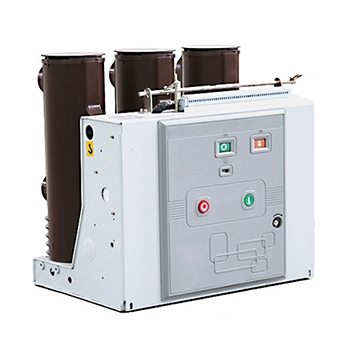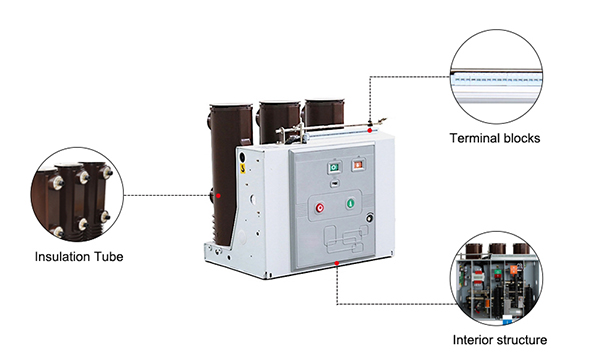What is a Vacuum Circuit Breaker?
The vacuum circuit breaker is named for its arc extinguishing medium and the insulating medium of the contact gap after arc extinguishing is all vacuums. It has the advantages of being small in size, lightweight, suitable for frequent operation, and no maintenance for arc extinguishing. Therefore, it is used in the distribution network the application is more popular. Next, ATO.com will introduce you to the definition, principle and structure of vacuum circuit breakers.
Working principle
The working principle of the vacuum circuit breaker is that when the static and dynamic contacts are opened under the action of the operating mechanism, an arc is generated between the contacts, and the surface of the contacts volatilizes steam at high temperatures. Because the contact is designed in a special shape, mechanical vacuum circuit breaker generates a magnetic field when the current passes. Under the action of this magnetic field, the arc moves rapidly along the tangential direction of the contact surface, and part of the metal vapor condenses on the metal cylinder (shield). The arc goes out naturally when it crosses zero, and the medium speed between the contacts quickly recovers.
The role of vacuum circuit breakers
- The contact opening distance is small, the contact opening distance of the 10kV vacuum circuit breaker is only about 10mm, the operating power of the operating mechanism is small, the stroke of the mechanical part is small, and its mechanical life is long.
- The arcing time is short and has nothing to do with the switching current, generally only half cycle.
- Due to the small amount of wear when the dredger breaks the current, the electrical life of the contacts is long, the full-capacity breaking is up to 30-50 times, the rated current is up to 5000 times, and the noise is small and suitable for frequent operations.
- After the arc is extinguished, the recovery speed of the medium in the contact gap is fast, and the performance of breaking faults in the near area is better.
- Small size, lightweight, suitable for breaking capacitive load current.
Structure
The structure of the vacuum circuit breaker is mainly composed of three parts: vacuum interrupter, operating mechanism, bracket, and other components.
Vacuum interrupter
The vacuum interrupter, also known as the vacuum switch tube, is the core component of the vacuum circuit breaker. Its main function is to quickly extinguish the arc and suppress the current after the medium and high voltage circuits are cut off through the excellent insulation performance of the vacuum in the tube, so as to avoid accidents and accidents.
Airtight insulation system
The airtight insulation shell made of glass or ceramics, the moving end cover, the fixed end cover, and the stainless steel bellows form an airtight insulation system. In order to ensure good airtightness between glass, ceramics, and metal, in addition to strict operating procedures when sealing, it is also required that the air permeability of the material itself is as small as possible, and the internal gas release is limited to a minimum value. The stainless steel bellows can not only isolate the vacuum state inside the vacuum interrupter from the external atmospheric state but also enable the moving contact and the moving conductive rod to move within the specified range to complete the on-and-off operations of the vacuum switch.
Conductive system
The fixed conductive rod, fixed running arc surface, fixed contact, moving contact, moving running arc surface, and moving conductive rod constitute the conductive system of the arc extinguishing chamber. Among them, the fixed conductive rod, the fixed running arc, and the fixed contact are collectively called the fixed electrode; the moving contact, the moving running arc, and the moving conductive rod are collectively called the moving electrode. When the vacuum circuit breaker, vacuum load switch, and vacuum contactor are closed, the operating mechanism closes the two contacts through the movement of the moving conductive rod and completes the connection of the circuit.
In order to make the contact resistance between the two contacts as small as possible and keep it stable, and to have good mechanical strength when the arc extinguishing chamber bears a stable current, the vacuum switch is equipped with a guide sleeve at one end of the moving conductive rod and uses a set of compression springs to make a rated pressure maintained between the two contacts. When the vacuum switch disconnects the current, the two contacts of the arc extinguishing chamber are separated and an arc is generated between them, until the arc is extinguished when the current naturally crosses zero, and the circuit is broken.
Shielding system
The shielding system of the vacuum interrupter is mainly composed of a shielding cylinder, shielding cover, and other parts. The main functions of the shielding system are:
- Prevent the contact from generating a large amount of metal vapor and liquid droplets during the arcing process to avoid polluting the inner wall of the insulating shell and causing a decrease in dielectric strength.
- Improving the electric field distribution inside the vacuum interrupter is conducive to the miniaturization of the insulating shell of the vacuum interrupter, especially for the miniaturization of the high-voltage vacuum interrupter.
- Absorb part of the arc energy and condense the arc products. Especially when breaking the short-circuit current, most of the heat energy generated by the arc is absorbed by the shielding system, which is conducive to improving the dielectric recovery strength between the contacts. The greater the amount of arc products absorbed by the shielding system, the greater the energy it absorbs, which plays a good role in increasing the breaking capacity of the vacuum interrupter.
- Contact system: The contact is the part where the arc is generated and extinguished, and the requirements for materials and structures are relatively high.
Structural requirements for vacuum circuit breakers
- The vacuum switching tubes used in the vacuum circuit breakers of the same type are interchangeable.
- There is a counter for recording the number of operations on the front panel of the circuit breaker.
- The circuit breaker is equipped with opening and closing buttons and opening and closing indicators.
- The circuit breaker should be equipped with a spring energy storage indicator.
- The metal box of the circuit breaker should have a grounding bolt with a diameter of 12mm that is anti-rust and good in conductivity and a grounding symbol should be marked near the grounding.
- The secondary circuit of the circuit breaker should be connected with wires and terminals, and the secondary circuit should be isolated from the main circuit.
- The insulation rod of the vacuum circuit breaker must apply a DC voltage of 20kV to test the leakage current.
Application
Vacuum circuit breakers are widely used in various links in the power system, such as transmission lines, substations, power distribution rooms, etc. Its main function is to disconnect the current in the circuit to protect the safety of electrical equipment and personnel. In the power system, high-voltage vacuum circuit breakers are usually used in conjunction with other protective equipment, such as lightning arresters, and disconnectors to achieve comprehensive protection of the power system.
A vacuum circuit breaker is an indoor power distribution device in a 3-10kV, 50Hz three-phase AC system, which can be used for protection and control of electrical equipment in industrial and mining enterprises, power plants, and substations, especially suitable for oil-free, fewer Places for maintenance and frequent operations. Circuit breakers can be configured in central cabinets, double-layer cabinets, and fixed cabinets for controlling and protecting high-voltage electrical equipment.

